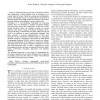96 search results - page 18 / 20 » Protecting browser state from web privacy attacks |
SP
2006
IEEE
14 years 1 months ago
2006
IEEE
Attackers and defenders of computer systems both strive to gain complete control over the system. To maximize their control, both attackers and defenders have migrated to low-leve...
CCS
2007
ACM
14 years 2 months ago
2007
ACM
Low-latency anonymity systems such as Tor, AN.ON, Crowds, and Anonymizer.com aim to provide anonymous connections that are both untraceable by “local” adversaries who control ...
ACSAC
2010
IEEE
13 years 5 months ago
2010
IEEE
Instruction-set randomization (ISR) is a technique based on randomizing the "language" understood by a system to protect it from code-injection attacks. Such attacks wer...
DASFAA
2009
IEEE
13 years 11 months ago
2009
IEEE
—Database security has become a vital issue in modern Web applications. Critical business data in databases is an evident target for attack. Therefore, ensuring the confidentiali...
CCS
2007
ACM
14 years 2 months ago
2007
ACM
An alarming trend in malware attacks is that they are armed with stealthy techniques to detect, evade, and subvert malware detection facilities of the victim. On the defensive sid...

